Standard [CURRENT]
ASTM F 2082/F 2082M:2023
Standard Test Method for Determination of Transformation Temperature of Nickel-Titanium Shape Memory Alloys by Bend and Free Recovery
- Publication date
- 2023
- Original language
- English
- Pages
- 8
- Publication date
- 2023
- Original language
- English
- Pages
- 8
- DOI
- https://dx.doi.org/10.1520/F2082_F2082M-23
Product information on this site:
Quick delivery via download or delivery service
Buy securely with a credit card or pay upon receipt of invoice
All transactions are encrypted
Short description
1.1 This test method describes a procedure for quantitatively determining the martensite-to-austenite or the martensite to R-phase transformation temperature of annealed, aged, shape-set, or tempered nickel-titanium alloy specimens by deforming the specimen in bending and measuring the deformation recovered during heating through the thermal transformation (BFR method). See 3.1.1 . Note 1: For aged, shape-set, or tempered specimens the transformation may be from martensite to austenite or from martensite to R-phase. See Reference ( 1 ) 2 for details. 1.2 The test specimen may be wire, tube, or strip or a specimen extracted from a semifinished or finished component. 1.2.1 For specimens not in the form of a wire, tube, or strip that are extracted from semifinished or finished components, a wire, tube, or strip shaped test specimen shall be made from the component such that the deformation mode in the test specimen is pure bending. 1.2.2 Other specimen geometries or displacements resulting in a more complex strain state, such as bending with torsion or buckling, are beyond the scope of this standard. 1.3 Ruggedness tests have demonstrated that sample Af must be limited to obtain good test results. See 5.6 for details. Ruggedness tests have demonstrated that deformation strain, deformation temperature, and equilibration time at the deformation temperature must be controlled to obtain good test results. See 9.1 , 9.2 , and 9.4 for details. 1.4 The values stated in either SI units or inch-pound units are to be regarded separately as standard. The values stated in each system may not be exact equivalents; therefore, each system shall be used independently of the other. Combining values from the two systems may result in nonconformance with this standard. 1.5 This standard does not purport to address all of the safety concerns, if any, associated with its use. It is the responsibility of the user of this standard to establish appropriate safety, health, and environmental practices and determine the applicability of regulatory limitations prior to use. 1.6 This international standard was developed in accordance with internationally recognized principles on standardization established in the Decision on Principles for the Development of International Standards, Guides and Recommendations issued by the World Trade Organization Technical Barriers to Trade (TBT) Committee.
ICS
77.120.50
DOI
https://dx.doi.org/10.1520/F2082_F2082M-23
Also available in
Loading recommended items...
Loading recommended items...
Loading recommended items...
Loading recommended items...

